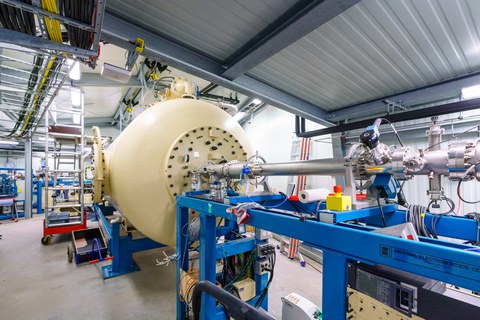May 17, 2021
Exploring the origin of the elements: TUD participates in EU network for research infrastructures in nuclear astrophysics

Dieser Untertage-Ionenbeschleuniger im gemeinsam von HZDR und TU Dresden errichteten Felsenkeller-Labor ist Teil der Forschungsinfrastruktur im Netzwerk.
Nuclear astrophysics is the science of how the elements of the periodic table have been created. This research field is served by a diverse set of research infrastructures of different sizes – from telescopes obtaining stellar spectra to laboratories studying element production to supercomputers needed to model these processes. To facilitate access to these specialized research facilities, the research infrastructure network ChETEC-INFRA has now been established, in which TU Dresden is prominently involved. The European Union is funding the network with five million euros until 2025.
ChETEC-INFRA gives researchers access to various national and regional research facilities. This includes the Dresden Felsenkeller Laboratory, which is jointly operated by TU Dresden and Helmholtz-Zentrum Dresden-Rossendorf (HZDR). Kai Zuber, professor of nuclear physics at TU Dresden and scientific director of the lab, explained: "The underground accelerator in the Felsenkeller Laboratory can be used to simulate fundamental processes that take place in all stars. Through ChETEC-INFRA, we are opening this experimental facility to interested scientists."
The coordinator of the EU network is Dr. Daniel Bemmerer from the Institute of Radiation Physics at HZDR and also the technical director of the Felsenkeller Laboratory. "I am thrilled to be working with such a diverse and high-caliber group of institutions in nuclear astrophysics," says Bemmerer. "In the next four years, ChETEC-INFRA will provide researchers across Europe with the tools they need to better understand hydrogen burning in the sun and the various processes involved in element formation."
ChETEC-INFRA also wants to inspire the next generation. "We will develop and conduct so-called Masterclasses," explains Dr. Uta Bilow from the Institute for Nuclear and Particle Physics at TU Dresden. "At these one-day events, high school students will get an introduction to the topic and can analyze data themselves to gain insight into nucleosynthesis."
With ChETEC-INFRA, key national and regional infrastructures open up EU-supported access for the entire European research community, streamlined through a unique portal for the three disciplines astronomy, laboratory nuclear astrophysics, and computational astrophysics. The network will especially encourage interdisciplinary proposals and aims to broaden the community by outreach to smaller EU countries with no established nuclear astrophysics groups.
The infrastructures range from the Nordic Optical Telescope on the Canary Islands to medium-sized telescopes in the Czech Republic, Lithuania, and Bulgaria. Nuclear laboratories allow to study element genesis by charged particle, neutron, or photon induced reactions, studying rare reactions with high beam intensities and high sensitivity, including an underground laboratory and accelerator mass spectrometry. A computing cluster with enough power to address nucleosynthesis in a massive star completes the list of infrastructures.
In order to enable use of the ChETEC-INFRA infrastructure by newcomers, in addition to the streamlined, EU-supported access also scientific support will be given. For example, the analysis of stellar spectra will be facilitated by standardised pipelines, abundance corrections, and rotational velocities. New targets and detectors serving the specialised needs of nuclear astrophysics researchers will be developed in the laboratories. The development and analysis of nucleosynthesis simulations will be facilitated by new software tools.
Media inquiries:
Prof. Kai Zuber
Tel.: 0351 463-42250
,
Dr. Uta Bilow
Tel.: 0351 463-32956
,
